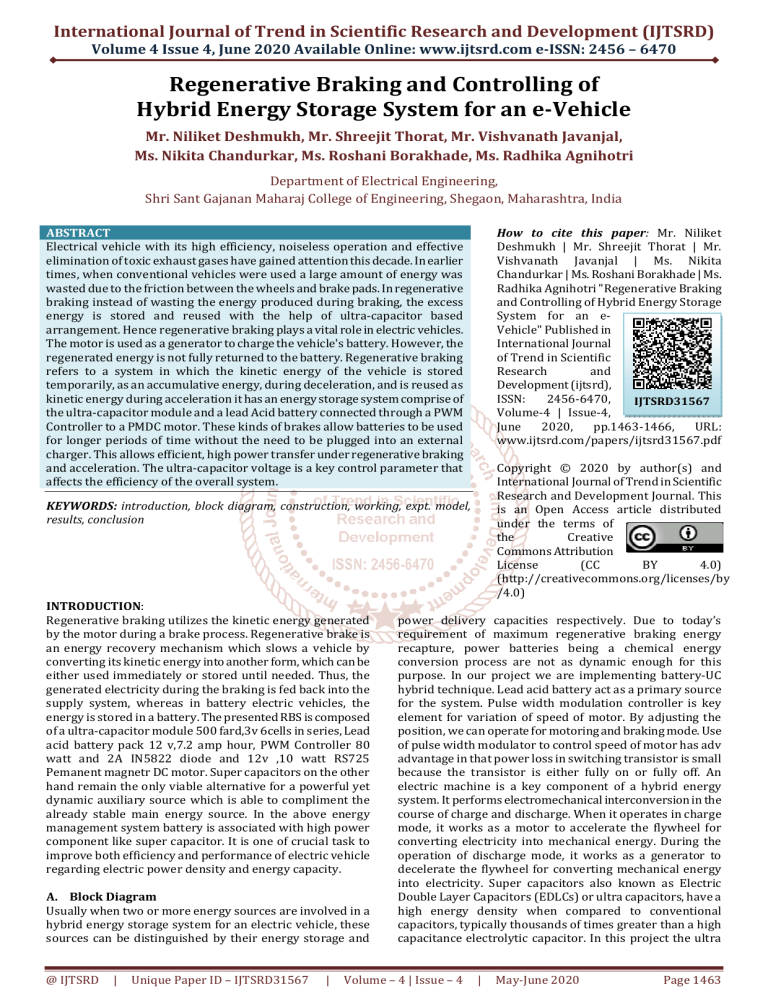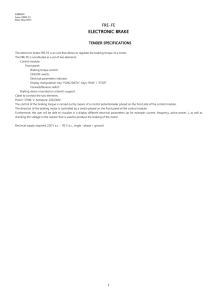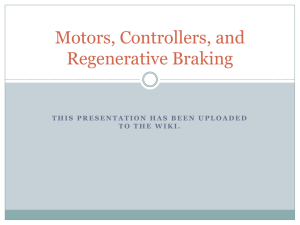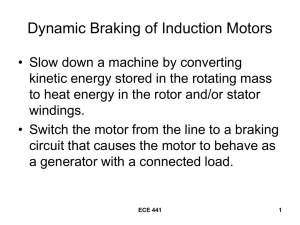
International Journal of Trend in Scientific Research and Development (IJTSRD)
Volume 4 Issue 4, June 2020 Available Online: www.ijtsrd.com e-ISSN: 2456 – 6470
Regenerative Braking and Controlling of
Hybrid Energy Storage System for an e-Vehicle
Mr. Niliket Deshmukh, Mr. Shreejit Thorat, Mr. Vishvanath Javanjal,
Ms. Nikita Chandurkar, Ms. Roshani Borakhade, Ms. Radhika Agnihotri
Department of Electrical Engineering,
Shri Sant Gajanan Maharaj College of Engineering, Shegaon, Maharashtra, India
How to cite this paper: Mr. Niliket
Deshmukh | Mr. Shreejit Thorat | Mr.
Vishvanath Javanjal | Ms. Nikita
Chandurkar | Ms. Roshani Borakhade | Ms.
Radhika Agnihotri "Regenerative Braking
and Controlling of Hybrid Energy Storage
System for an eVehicle" Published in
International Journal
of Trend in Scientific
Research
and
Development (ijtsrd),
ISSN:
2456-6470,
IJTSRD31567
Volume-4 | Issue-4,
June
2020,
pp.1463-1466,
URL:
www.ijtsrd.com/papers/ijtsrd31567.pdf
ABSTRACT
Electrical vehicle with its high efficiency, noiseless operation and effective
elimination of toxic exhaust gases have gained attention this decade. In earlier
times, when conventional vehicles were used a large amount of energy was
wasted due to the friction between the wheels and brake pads. In regenerative
braking instead of wasting the energy produced during braking, the excess
energy is stored and reused with the help of ultra-capacitor based
arrangement. Hence regenerative braking plays a vital role in electric vehicles.
The motor is used as a generator to charge the vehicle's battery. However, the
regenerated energy is not fully returned to the battery. Regenerative braking
refers to a system in which the kinetic energy of the vehicle is stored
temporarily, as an accumulative energy, during deceleration, and is reused as
kinetic energy during acceleration it has an energy storage system comprise of
the ultra-capacitor module and a lead Acid battery connected through a PWM
Controller to a PMDC motor. These kinds of brakes allow batteries to be used
for longer periods of time without the need to be plugged into an external
charger. This allows efficient, high power transfer under regenerative braking
and acceleration. The ultra-capacitor voltage is a key control parameter that
affects the efficiency of the overall system.
Copyright © 2020 by author(s) and
International Journal of Trend in Scientific
Research and Development Journal. This
is an Open Access article distributed
under the terms of
the
Creative
Commons Attribution
License
(CC
BY
4.0)
(http://creativecommons.org/licenses/by
/4.0)
KEYWORDS: introduction, block diagram, construction, working, expt. model,
results, conclusion
INTRODUCTION:
Regenerative braking utilizes the kinetic energy generated
by the motor during a brake process. Regenerative brake is
an energy recovery mechanism which slows a vehicle by
converting its kinetic energy into another form, which can be
either used immediately or stored until needed. Thus, the
generated electricity during the braking is fed back into the
supply system, whereas in battery electric vehicles, the
energy is stored in a battery. The presented RBS is composed
of a ultra-capacitor module 500 fard,3v 6cells in series, Lead
acid battery pack 12 v,7.2 amp hour, PWM Controller 80
watt and 2A IN5822 diode and 12v ,10 watt RS725
Pemanent magnetr DC motor. Super capacitors on the other
hand remain the only viable alternative for a powerful yet
dynamic auxiliary source which is able to compliment the
already stable main energy source. In the above energy
management system battery is associated with high power
component like super capacitor. It is one of crucial task to
improve both efficiency and performance of electric vehicle
regarding electric power density and energy capacity.
A. Block Diagram
Usually when two or more energy sources are involved in a
hybrid energy storage system for an electric vehicle, these
sources can be distinguished by their energy storage and
@ IJTSRD
|
Unique Paper ID – IJTSRD31567
|
power delivery capacities respectively. Due to today’s
requirement of maximum regenerative braking energy
recapture, power batteries being a chemical energy
conversion process are not as dynamic enough for this
purpose. In our project we are implementing battery-UC
hybrid technique. Lead acid battery act as a primary source
for the system. Pulse width modulation controller is key
element for variation of speed of motor. By adjusting the
position, we can operate for motoring and braking mode. Use
of pulse width modulator to control speed of motor has adv
advantage in that power loss in switching transistor is small
because the transistor is either fully on or fully off. An
electric machine is a key component of a hybrid energy
system. It performs electromechanical interconversion in the
course of charge and discharge. When it operates in charge
mode, it works as a motor to accelerate the flywheel for
converting electricity into mechanical energy. During the
operation of discharge mode, it works as a generator to
decelerate the flywheel for converting mechanical energy
into electricity. Super capacitors also known as Electric
Double Layer Capacitors (EDLCs) or ultra capacitors, have a
high energy density when compared to conventional
capacitors, typically thousands of times greater than a high
capacitance electrolytic capacitor. In this project the ultra
Volume – 4 | Issue – 4
|
May-June 2020
Page 1463
International Journal of Trend in Scientific Research and Development (IJTSRD) @ www.ijtsrd.com eISSN: 2456-6470
capacitor act as auxiliary source in the system. Super
capacitor captures the energy whatever it is wasted during
regenerative braking.
CONSTANT SPEED:
In this mode of operation, to get the constant rated speed of
motor, we gradually increase the speed of the motor by
increasing the terminal voltage of motor by PWM controller.
And hence, the rated speed of motor can be achieved and
motor rotates with constant speed. In this mode, the
terminal voltage of the motor is maintained constant at 12 v
however, the armature current must maintain its direction.
DEACCELEARTION AND BRAKING MODE:
In this mode of operation, as soon as the DPDT switch is
shifted to braking mode, the motor slows down and starts
acting as a genearator and back emf of motor, battery voltage
gets reduced. At the same time, the energy which get
produced during braking is get absorbed by the Super
capacitor, which is fed through the alternate unidirectional
circuit. And Hence, the Regenerative Braking takes place.
While during Braking, the energy absorbed by the Super
capacitor depends on the energy produced by motor during
braking, speed at which braking takes place, and moment of
inertia of motor. And therefore, the voltage of Super
capacitor increases above 12 volt and it gets charged. The
diode is used in braking circuit to avoid reverse current flow
while Motoring.
B. Construction Diagram and description
Figure Circuit diagram
The most basic method of combining a super capacitor with
battery pack is a simple way of parallel configuration. In this
parallel topology Battery system, PMDC Motor, DPDT switch,
DC ammeter, Digital Multimeters, Diodes and small flywheel
is used.
Explaination in detail
Modes of operation and control strategy of an Electrical
Drive. An Electrical Drive has different modes of operation,
which is given by
Starting and Acceleration mode;
Constant speed
Deceleration or braking mode
C. Principle and Methodology
Regenerative braking is an energy recovery mechanism that
slows down a moving vehicle or object by converting its
kinetic energy into a form that can be either used
immediately or stored until needed. In this mechanism, the
electric traction motor uses the vehicle's momentum to
recover energy that would otherwise be lost to the brake
discs as heat. This contrasts with conventional braking
systems, where the excess kinetic energy is converted to
unwanted and wasted heat due to friction in the brakes, or
with dynamic brakes, where the energy is recovered by
using electric motors as generators but is immediately
dissipated as heat in resistors. In addition to improving the
overall efficiency of the vehicle, regeneration can
significantly extend the life of the braking system as the
mechanical parts will not wear out very quickly. Electric
motors, when used in reverse, function as generators and
will then convert mechanical energy into electrical energy.
Vehicles propelled by electric motors use them as generators
when using regenerative braking, braking by transferring
mechanical energy from the wheels to an electrical load.
D. Experimental Model and Observations
Here are some observations of our project which are
considered before and after braking.
Before braking:
STARTING AND ACCELERATION MODE:
During normal working condition, the DPDT switch is kept in
motoring mode. The speed of the dc motor is controlled by
armature voltage control method, which is directly
proportional to its terminal voltage. Controller will drive the
motor and control the power flow. During starting and
accelerating, motor will demand more current which will fed
through the hybrid source of energy. In this stage the
armature current flows through positive terminal of source
to negative terminal .Diode is used to avoid the reverse
current flow during breaking. Hence during normal driving
mode, the power will be delivered by both battery and super
capacitor.
@ IJTSRD
|
Unique Paper ID – IJTSRD31567
|
Volume – 4 | Issue – 4
|
May-June 2020
Page 1464
International Journal of Trend in Scientific Research and Development (IJTSRD) @ www.ijtsrd.com eISSN: 2456-6470
At initial condition: The super capacitor is in discharged
mode. PWM controller is at minimum position. Switch is
kept in motoring mode. Motor is at rest.
At Running Condition: Now we gradually increase the
speed of motor by using PWM Controller up to rated
speed.
After Braking:
Following are the observations before braking:
Terminal Voltage (Vt) = 12.09 V
Motor Current (Ia) = 0.74 A
Capacitor Voltage (Vc) = 2.60 V
At Braking Condition: Switch is changed to braking mode. Due to regenerative braking, the wasted energy gets stored in the
super capacitor.
Following are the observations after braking;
Terminal Voltage (Vt) = decreases from 4 to 0
Motor Current (Ia) = decreases from 2.8 to 0
Capacitor Voltage (Vc) = 2.66
E. Numerical Equations
As per observations initially self discharge test of super capacitor was tested. The module of super capacitor was firstly charged
by the constant dc power supply and was tested under constant current rates, where the change in capacitance was found to be
decrease for increased charging rates. Further the testing of super capacitor module under the regenerative braking had been
done in main proposed system, in order to justify study analysis regarding super capacitor, we have studied technical terms in
detail. Moreover, energy consumed by the super capacitor module for a 20 min interval was calculated.
Power Supply Voltage
V0
3.7
12
Charging
V1 T sec
10 20.5
I
1
V0
10
Discharging
V1 T sec
I
3.7
20
0.7
Calculations for Ultra Capacitor- 500F, 3V (six cells are
connected in series)
1. Ceq = 500/6 = 83.33F
2. Energy stored: E=1 CV2
2
= (1/2)*500*9
= 2250 = 2250/600 = 0.625-watt hr
3.
Minimum allowable energy: %d= (Vmin) X 100
(Vmax)
=3.7 X 100
=37%
10
4.
⋂
Ampere hour efficiency:
=
dis current X time of dis
Charge current X time of charge
= 0.6X20X60 = 58.53%
1X20.5X60
5. Watt hour efficiency:
⋂
=
time of disXdis current X dis voltage
time of charge X charging current X charging voltage
= 20X60X0.6 (3.7) = 21.6%
20.5X60X1 (10)
Watt hour efficiency
Ampere hour efficiency
21.65%
58.53%
RESULT:
1X20.5X60As per observations initially self discharge test of
super capacitor was tested. Likewise, the charging current
and discharging current was monitored and effective value
was calculated. Moreover, energy consumed by the super
capacitor module for a 20 min interval was calculated The
ampere-hour and watt-hour efficiency of super capacitor
was also calculated and found to be 58.53% and 21.65%. In
the topology of the given hardware implemented system, it is
observed that motor stops running within a time, based on
super capacitor charging current .The operating
fundamentals of the proposed hybrid energy storage system
were explained in detail especially in two different operating
modes .DPDT switch was used to change the operating
modes and finally the braking current and braking time were
noted. In this, motor initially powered by the battery to
operate drive system in driving mode. As soon as switching
takes place for braking mode which will further allow the
controller to operate motor for regenerative braking. From
this it is observed that super capacitor gives the better
performance for electric vehicle and its implementation in
regenerative braking will certainly be used to improve
energy recovery from the system. The control of vehicle
speed during all modes of operation (motoring, constant
speed and braking) should be maintained for the proper EV
operation. In this way, we can capture up to 8-25% of the
energy otherwise wasted during braking.
= 0.6X20X60 = 58.53%
@ IJTSRD
|
Unique Paper ID – IJTSRD31567
|
Volume – 4 | Issue – 4
|
May-June 2020
Page 1465
International Journal of Trend in Scientific Research and Development (IJTSRD) @ www.ijtsrd.com eISSN: 2456-6470
F. CONCLUSION:
In this paper, regenerative braking for hybrid energy storage
system for electric vehicle is mainly focused and hence the
given prototype is developed. Regenerative braking system
were experimentally verified in the laboratory. Final reading
on dc motor had been taken on the given proposed system.
Motor is tested on both motoring mode as well as braking
mode. Finally, it is observed that energy produced during
braking operation in motor is get stored in super capacitor
successfully. Additionally, the stored energy is reused during
the acceleration or high current demand of the motor. The
calculations regarding thesis analysis were studied and
calculated successfully.
In this way by implementing technology of super capacitor in
hybrid energy storage system especially in regenerative
braking gives better performances and ultimately reduce
stress over the battery and improve its life. Further the
efficiency of overall system is dependent on braking rate and
initial super capacitor state of charge (SOC). The highest
regenerative braking power that super capacitor can capture
is likely to occur when the super capacitor SOC is at its
lowest level.
Acknowledgment (Heading 5)
We first pray to our divine source of inspiration “Shri Sant
Gajanan Maharaj” whose blessings are always with us.
We express our deep gratitude to our Respected Director Mr.
Shrikantdada Patil for his kind blessings encouragement and
providing us such a good opportunity. No words could be
good enough to express our deep gratitude to our respected
Principal Dr. S. B. Somani for his kind blessings, inspiration
and providing us the necessary support. We feel great
pleasure in expressing our deepest sense of gratitude and
sincere thanks for valuable guidance, extreme assistance and
cooperation extended to us by our Internal Guide Dr. S. R.
Paraskar and our co-Guide Prof. A. K. Damral sir in
preceding the completion of the dissertation. We are equally
indebted to Dr. S. R. Paraskar (Head of Electrical
department) for extending necessary help, providing
facilities and time-to-time valuable guidance. We are
especially thankful to Prof. P. R. Bharambe, Prof. R. S.
Kankale, Prof. S. S. Jadhao & Prof Pratik Dhabe for their
valuable suggestions and inspiration time to time.
@ IJTSRD
|
Unique Paper ID – IJTSRD31567
|
This acknowledgement would be incomplete without
expressing our special thanks to Prof. U. A. Jawadekar and
Dr. Mrs. A. U. Jawadekar for their support during the work.
Last but not least, we would like to thanks all the teaching,
non-teaching staff members of the Electrical Engineering
Department, our family members and colleagues those who
helped us directly or indirectly for completing this task
successfully.
REFERENCES
[1] J. Clerk Maxwell, A Treatise on Electricity and
Magnetism, 3rd ed., vol. 2. Oxford: Clarendon, 1892,
pp.68-73. A Comprehensive Study of Key Electric
Vehicle (EV) Components, Technologies, Challenges,
Impacts, and Future Direction of Development Fuad
Un-Noor 2. Sanjeevikumar Padmanaban 3. Lucian
Mihet-Popa 4. Mohammad Nurunnabi Mollah and 5.
Eklas Hossaian. Academic Editor: Sergio Saponara
Received: 8 May 2017; Accepted: 21 July 2017;
Published: 17 August 2017
[2] Ultra capacitors: why, how, and where is the
technology. Andrew Burke. Institute of Transportation
Studies, University of California-Davis, Davis, CA
95616, USA
[3] Simulation and Analysis of Performance of a Pure
Electric Vehicle with a Super-capacitor Jinrui N', Zhifu
W', Qinglian R2 'School of mechanical and vehicular
engineering, Beijing Institute of Technology, Beijing,
Chin
[4] Regenerative braking of an electric vehicle using ultra
capacitors and a Buck-Boost Converter Juan W. Dixon,
Micah Ortúzar and Eduardo Wiechmann* Department
of Electrical Engineering Catholic University of Chile
Casilla 306, Correo 22 Santiago, Chile
[5] R. Nicole O. Hegazy, J. Van-Mierlo, and P. Lataire,
‘‘Analysis, modeling, and implementation of a
multidevice interleaved DC/DC converter for fuel cell
hybrid electric vehicles,’’ IEEE Trans. Power Electron.,
vol. 27, no. 11, pp. 4445-4458, Jan. 2012
[6] X. Jiaqun and C. Haotian, "Regenerative brake of
brushless DC motor for light electric vehicle," Electrical
Machines and Systems (ICEMS), 2015 18th
International Conference on, Pattaya, 2015, pp. 14231428. doi: 10.1109/ICEMS.2015.7385262
Volume – 4 | Issue – 4
|
May-June 2020
Page 1466



